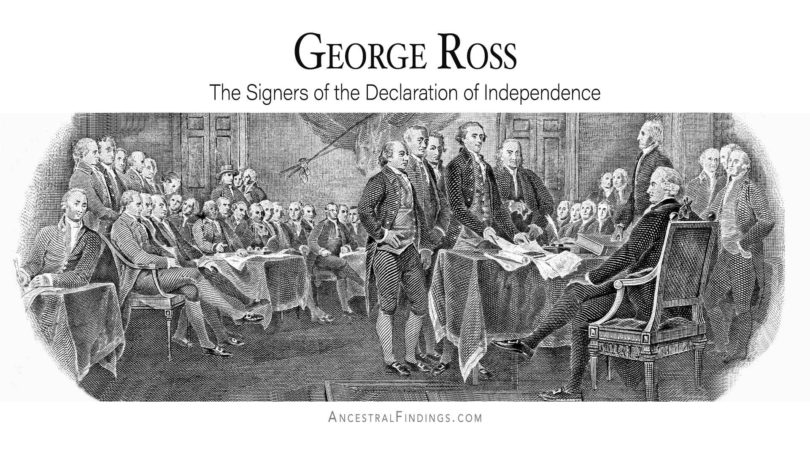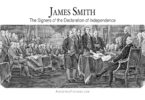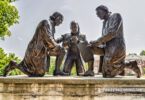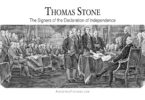George Ross was born in 1730 in New Castle, Delaware, one of sixteen children born to his Scottish minister father and one of eleven children born to his mom, who was his father’s second wife. George’s father was the Reverend George Aeneas, 5th Laird Balblair Ross, a member of a noble Scottish family whose paternal line could be traced to Farquhar O’ Beollain, who was named 1st Earl of Ross by King Alexander II of Scotland in 1226.
As with most of his siblings, George was educated at home. Later, he studied law at the office of his half-brother, John, and after completing those studies, was admitted to the bar as a lawyer in Philadelphia. Once he became a lawyer, George was initially on the Tory (Crown) side of politics, serving as Crown Prosecutor for twelve years before being elected to the provincial legislature in 1768.
While on the provincial legislature, George served on the Committee of Safety. While there, his sympathies began to change for the first time, from Tory to Continental. George became a strong supporter of the colonial legislatures in their many disputes with Parliament in Great Britain.

After serving on the provincial legislature, he was appointed to the Continental Congress, where he became a signer of the Declaration of Independence. While serving on the Congress, George simultaneously served as a colonel in the Pennsylvania militia and as Vice-President of the first constitutional convention for Pennsylvania. After resigning from the Continental Congress in 1777, mostly because of his questionable health at the time, he went home and was appointed to the Pennsylvania Court of Admiralty. He served in that position until he crossed over to the other side at forty-nine years old, of a bad bout of gout, in 1779.
George’s sister, Gertrude, after becoming the widow of Thomas Till, married George Read, who was a fellow signer of the Declaration of Independence. In addition, one of George’s nephews married a woman named Betsy Griscom in 1773, the same Betsy who famously became known as Betsy Ross, the American flag celebrity.
As for George’s personal life, it was in 1750, at only twenty years old, that he was admitted to the bar and established his own law practice in Lancaster, Pennsylvania. The following year, he married Ann Lawler in Lancaster, Pennsylvania. Together, the couple had two sons and a daughter, named George, James, and Mary. Interestingly, George and Ann met because she came to him when she was seeking the counsel of a lawyer when she was nineteen years old. In fact, she was one of George’s first clients.
There are no records that record exactly why a young, single, teenage girl was seeking the advice of a lawyer. It was certainly an unusual situation for those times. It may have had to do with property or money matters, as Ann was an only child whose father had crossed to the other side when she was still a child, leaving her and her mom, Mary Lawler, seemingly alone in the world, with no other known relatives in the Lancaster area or any area nearby.
Whatever the reason, she and George turned their professional relationship into a personal one. They soon fell in love and were married the following year. Local publications reported that their marriage was “considered a highly advantageous union for both,” primarily because of their similar backgrounds, the number of properties they each owned, and their amiable personalities. They became one of Lancaster’s most popular and beloved couples.
Ann was particularly noted for her beauty. Once she had children, the locals remarked on how attractive the children were, too. At dinner one night, a guest convinced George that it would be an excellent idea for him and Ann to have their portraits done, and the guest suggested a new artist to the town to do the job. Ann and George each sat for individual portraits, and Ann’s celebrated beauty definitely comes across in her portrait. The portraits were so good, in fact, that they were greatly admired by all of the city, and brought a certain celebrity to the artist, who gained a lot of new business thanks to them.
Ann crossed over to the other side in 1773, at only forty years old, and is buried at the St. James Episcopal Church Cemetery in Lancaster, as are her son George and daughter Mary (all of Ann and George’s children lived past childhood, and George and Mary wed and stayed in the area, while James went to Louisiana and is not known to have had any issue). Their formerly marked graves are among the two hundred in the cemetery that is no longer marked in the modern era.
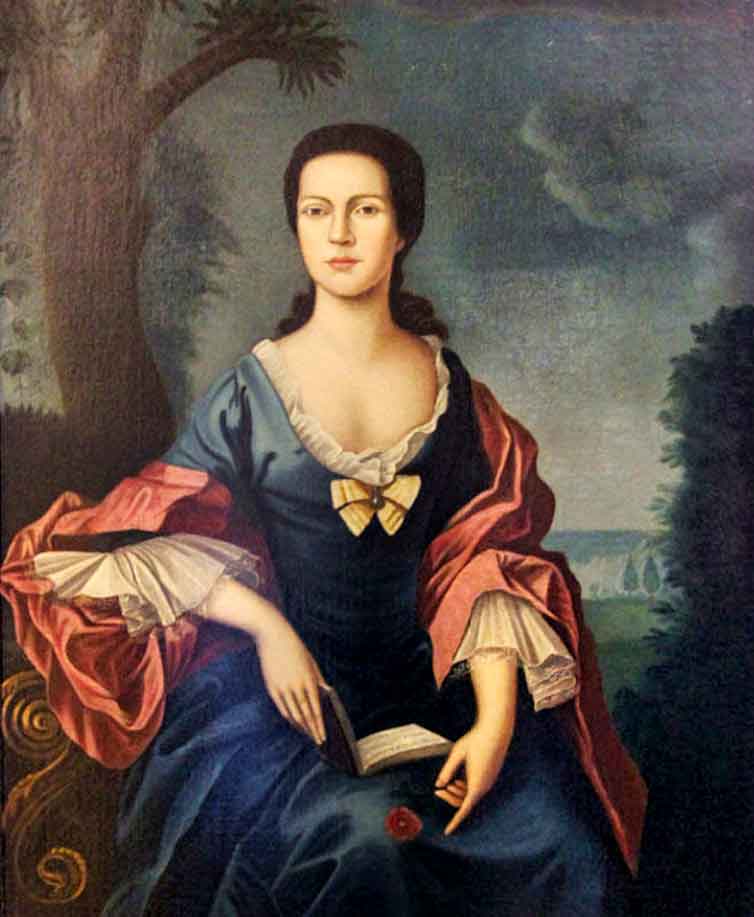
As for George, he went on for a few years after Ann but never remarried. After resigning from the Continental Congress, while serving on the Admiralty Court of Pennsylvania, an appeals court of Congress overruled his decision in a case that involved a dispute between two citizens of different states. George refused to acknowledge the authority of the higher Congressional court, as he did not believe it had the authority to overturn decisions made in the individual states. This prompted a legal dispute about states’ rights that was not resolved until 1809.
While he is not the best known of the signers of the Declaration of Independence, George Ross nonetheless left an important mark on the earliest days of the new United States. He and his wife did not witness the end of the American Revolution, but both of their sons fought in it, and George’s work in his various offices helped to lay the foundations of the new nation. With his family connections to other well-known patriot families of the day, George Ross is part of the fabric of America as we know it today.
George’s final resting place is at the Christ Church Burial Ground in Philadelphia, Pennsylvania.

